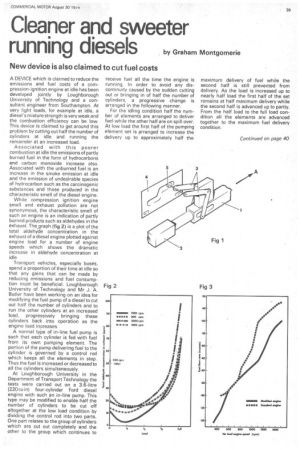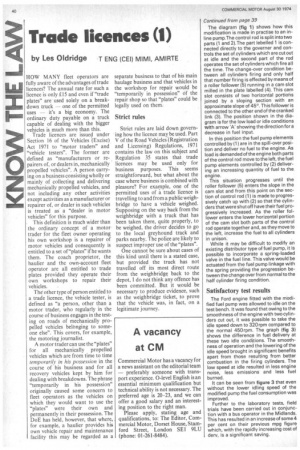Cleaner an d sweeter
Page 41

Page 42

If you've noticed an error in this article please click here to report it so we can fix it.
running diesels
by Graham Montgomerie
New device is also claimed to cut fuel costs
A DEVICE which is claimed to reduce the emissions and fuel costs of a com pression-ignition engine at idle has been developed jointly by Loughborough University of Technology and a consultant engineer from Southampton. At very light loads, for example at idle, a diesel's mixture strength is very weak and the combustion efficiency can be low. This device is claimed to get around this problem by cutting out half the number of cylinders at idle and running the remainder at an increased load.
Associated with this poorer combustion at idle the emissions of partly burned fuel in the form of hydrocarbons and carbon monoxide increase also. Associated with the unburned fuel is an increase in the smoke emission at idle and the emission of undesirable species of hydrocarbon such as the carcinogenic substances and those produced in the characteristic smell of the diesel engine.
While compression ignition engine smell and exhaust pollution are not synonymous, the characteristic smell of such an engine is an indication of partly burned products such as aldehydes in the exhaust. The graph (fig 2) is a plot of the total aldehyde concentration in the exhaust of a diesel engine plotted against engine load for a number of engine speeds which shows the dramatic increase in aldehyde concentration at idle.
Transport vehicles, especially buses, spend a proportion of their time at idle so that any gains that can be made by reducing emissions and fuel consumption must be beneficial. Loughborough University of Technology and Mr J. A. Butler have been working on an idea for modifying the fuel pump of a diesel to cut out half the number of cylinders and to run the other cylinders at an increased load, progressively bringing these cylinders back into operation as the engine load increases.
A normal type of in-line fuel pump is such that each cylinder is fed with fuel from its own pumping element. The portion of the pump delivering fuel to the cylinder is governed by a control rod which keeps all the elements in step. Thus the fuel is increased or decreased to all the cylinders simultaneously.
At Loughborough University in the Department of Transport Technology the tests were carried out on a 3.6-litre {220 cu in) four-cylinder Ford diesel engine with such an in-line pump. This type may be modified to enable half the number of cylinders to be cut off altogether at the low load condition by dividing the control rod into two parts. One part relates to the group of cylinders which are cut out completely and the other to the group which continues to receive fuel all the time the engine is running. In order to avoid any discontinuity caused by the sudden cutting out or bringing in of half the number of cylinders, a progressive change is arranged in the following manner.
For the idling condition half the number of elements are arranged to deliver fuel while the other half are on spill over. At low load the first half of the pumping element set is arranged to increase the delivery up to approximately half the maximum delivery of fuel while the second half is still prevented from delivery. As the load is increased up to nearly half load the first half of the set remains at half maximum delivery while the second half is advanced up to parity. From the half load to the full load condition all the elements are advanced together to the maximum fuel delivery condition.
The diagram (fig 1) shows how this modification is made in practise to an inline pump.The control rod is split i nto two parts (1 and 2). The part lebelled 1 is connected directly to the governer and controls the set of cylinders which are cut out at idle and the second part of the rod operates the set of cylinders which fire all the time. The change-over condition between all cylinders firing and only half that number firing is effected by means of a roller follower (5) running in a cam slot milled in the plate labelled (4). This cam slot consists of two horizontal portions joined by a sloping section with an approximate slope of 45°. This follower is connected to the other end of the cranked link (3). The position shown in the diagram is for the low load or idle conditions vvith arrow 'A' showing the direction for a decrease in fuel input.
In this position the fuel pump elements controlled by (1) are in the spill-over position and deliver no fuel to the engine. As load is demanded of the engine both parts of the control rod move to the left, the fuel pump elements controlled by (2) delivering an increasing quantity of fuel to the engine.
This situation progresses until the roller follower (5) enters the slope in the cam slot and from this point on the section of control rod (1) is made to progressively catch up with (2) so that the cylinders that were shut off have their fuel progressively increased. As the roller follower enters the lower horizontal portion of the cam slot both parts of the control rod operate together and, as they move to the left, increase the fuel to all cylinders in unison.
While it may be difficult to modify an existing distributor type of fuel pump, it is possible to incorporate a spring-loaded valve in the fuel line. This valve would be actuated from the fuel pump linkage with the spring providing the progression between the change over from normal to the half cylinder firing condition.
Satisfactory test results
The Ford engine fitted with the modified fuel pump was allowed to idle on the test bench. It was found that owing to the smoothness of the engine with two cylinders cut out, it was possible to take the idle speed down to 320rpm compared to the normal 450rpm. The graph (fig 3) shows the difference in fuel delivery at these two idle conditions. The smoothness of operation and the lowering of the idle speed brought in significant benefits apart from those resulting from better combustion in the firing cylinders. The low speed at idle resulted in less engine noise, less emissions and less fuel burned.
It can be seen from figure 3 that even without the lower idling speed of the modified pump the fuel consumption was improved.
Further to the laboratory tests, field trials have been carried out in conjunction with a bus operator in the Midlands. This has resulted in an increase of some 4 per cent on their previous mpg figure which, with the rapidly increasing cost of derv, is a significant saving.




































































































